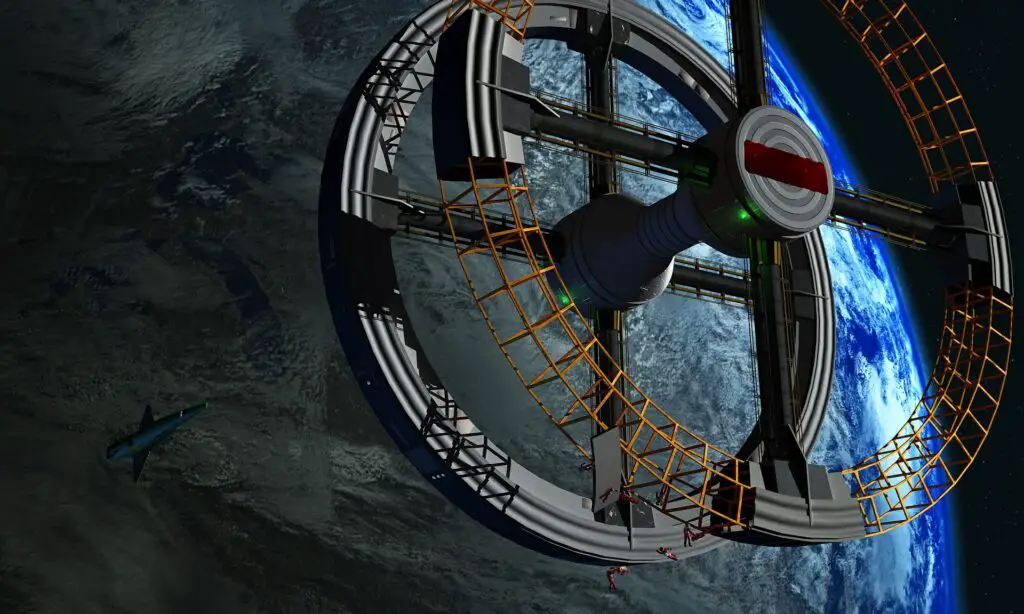The plans to develop space habitat with artificial gravity have remained science fiction, but we are close to rewriting history. Japanese researchers recently announced their plans to build a space habitat with artificial gravity to accommodate humans on the moon and mars. Here are their plans to accomplish this futuristic plan.
How Japanese Researchers plan to develop a space habitat with artificial gravity
On July 5, during a conference, a team of researchers from Kyoto University and Kajima Corporation (a construction firm) revealed their futuristic architectural designs of artificial gravity space habitat to the audience. The shape of this futuristic habitat is quite fascinating to accommodate lunar and Martian explorers in a few decades to come.
The team revealed that this space habitat would have a 1,300ft tall rotating structure that will complete every 20 seconds. The rotating space habitat named ‘The Glass’ will use centrifugal force to generate artificial gravity for humans inhabiting the futuristic habitat. Astronauts aboard this habitat will surely experience the same gravity they used to feel on earth.
The team also intends to design this futuristic habitat for atmospheric conditions on the lunar surface and Mars. This implies that astronauts hoping to explore the lunar surface in the future will feel at home while conducting their research in outer space. Japanese local paper reports that the team targets completing a prototype of this futuristic space habitat on the moon by 2050. The habitat will be built in the polar region of the moon.
Why Japanese Researchers intend to develop A Space Habitat with Artificial Gravity

Since the mid-20th century, we have sent robotic space probes astronauts to outer space. Despite the devastating nature of space, humans have continued to conduct their research aboard space stations orbiting the earth. For decades, astronauts have relied on visiting space and staying on a space station without artificial gravity.
As we embrace the 21st century, we have become technologically advanced to provide astronauts with artificial gravity on space stations. But due to the cost of developing this project, no space agency currently wants to look toward building a space station with artificial gravity.
Japanese Researchers saw this as an opportunity to change how we explore space in the modern age. So, they came up with the idea of building a space habitat to provide future space explorers with artificial gravity. These researchers at Kyoto University have started collaborating with Jiama Corp to develop gravity-defying space habitats for the moon and Mars explorers.
Yosuke Yamashiki, who works as the director of the SIC Human Spaceology Center of Kyoto University, stated his team’s goal during the July 5 conference. According to Yamashiki, this plan is unique as other countries have not started considering developing similar plans for the future.
He went ahead to describe the essential technologies that will enable humans to succeed in exploring deep space in the future. Yamashiki clearly explains the role of gravity in the birth and growth of infants and kids in the weightless space environment. He further describes how humans born in an environment with low gravity will likely experience several challenges, especially if they attempt to return to earth.
Hence, the critical point of this space habitat is to give astronauts earth-like gravity to build colonies on the Moon and Mars. The future space habitat was displayed at the conference as a video showing a habitable environment filled with green pasture and water-like earth. From the look of things, this habitat looks fascinating to protect the human species on the lunar and Martian surfaces.
The researchers revealed that the Glass installed on the moon would be named Lunar Glass, while the habitat that will be installed on the red planet will be named Mars Glass. Yamashiki also revealed that the construction of these habitats is massively quite impossible considering our current level of technology.
However, he firmly believed that human civilization in the 22nd century would advance technologically and take construction to another level. Yamashiki stated their plans to build a simple version of this habitat in 2050 on the lunar surface.
Their success in a few decades will determine when they will take this futuristic plan to the martian surface. The team also plans to build an interplanetary transportation system named “Hexagon space track system” to make space exploration appear easier for humanity. The future looks fascinating with these futuristic plans made by Japanese researchers.
Conclusion
Exploring space has been the primary goal of the human race, but we cannot attain a more significant milestone without solving the gravity problem in outer space. With this futuristic plan mapped out by Japanese researchers, space exploration’s future is already attractive. Let’s hope that they succeed in their goals. What do you think about this plan created by these Japanese researchers?




